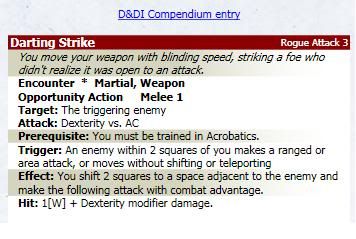Black Knight Irios
Explorer
Ok seems we still agree on disagreeing. I try once more to get my point across.
Above is the complete text on sneak attack (SA) from the update. Lets take just the part that tells us when we are allowed to apply SA.
Once again step by step.
1) red must be true
2) green must be true
3) they must be true in that order (1 then 2) and they must be both true (1 and 2)
4) now you are allowed to apply SA to the damage roll
OTOH, you seem not to care at what point before the damage roll you have CA, you would allow 2 then 1 as well. But as I read and interpret it, it must be before you hit, so only 1 then 2 is possible.
EDIT:
I can see where your interpretation comes from.
Sometimes when we connect things with an AND it doesn't matter which comes first, like:
My car is fast and cool. <<>> My car is cool and fast. No change in meaning.
Another sentence:
When we have food in our mouth we chew and swallow. Turning this around leads to: When we have food in our mouth we swallow and chew. The sentence is still sensible but the order of the two actions is not corret. You can't chew something that has been swallowed.
Therefore, when I read a sentence with an AND I ask is the order important - would the meaning change if I turned it around - if the answer is yes, the meaning would change, it's the order of "events" and it should not be changed.
Now regarding our sneak attack issue I say I read it as written with the written order b/c turning it around opens up another possibility when you are allowed to apply SA. Since WotC did not make it clear wether turning around is allowed/intended or not we don't know who's right. Since you allow both readings you're at least 50% right.
May 2010 Update Sneak Attack said:Once per round, when you have combat advantage against an enemy and hit that enemy with an attack that uses a crossbow, a light blade, or a sling, the attack deals extra damage. If you have dealt Sneak
Attack damage since the start of your turn, you cannot deal it again until the start of your next turn. You decide whether to apply the extra damage after making the damage roll. As you advance in level, your extra damage increases.
Above is the complete text on sneak attack (SA) from the update. Lets take just the part that tells us when we are allowed to apply SA.
So you want to use your SA to kill that pesky monster faster, but how do you know that you can use SA?when you have combat advantage against an enemy and hit that enemy with an attack [weapon usage mumbo jumbo] the attack deals extra damage.
Once again step by step.
1) red must be true
2) green must be true
3) they must be true in that order (1 then 2) and they must be both true (1 and 2)
4) now you are allowed to apply SA to the damage roll
OTOH, you seem not to care at what point before the damage roll you have CA, you would allow 2 then 1 as well. But as I read and interpret it, it must be before you hit, so only 1 then 2 is possible.
EDIT:
I can see where your interpretation comes from.
Sometimes when we connect things with an AND it doesn't matter which comes first, like:
My car is fast and cool. <<>> My car is cool and fast. No change in meaning.
Another sentence:
When we have food in our mouth we chew and swallow. Turning this around leads to: When we have food in our mouth we swallow and chew. The sentence is still sensible but the order of the two actions is not corret. You can't chew something that has been swallowed.
Therefore, when I read a sentence with an AND I ask is the order important - would the meaning change if I turned it around - if the answer is yes, the meaning would change, it's the order of "events" and it should not be changed.
Now regarding our sneak attack issue I say I read it as written with the written order b/c turning it around opens up another possibility when you are allowed to apply SA. Since WotC did not make it clear wether turning around is allowed/intended or not we don't know who's right. Since you allow both readings you're at least 50% right.
Last edited:





